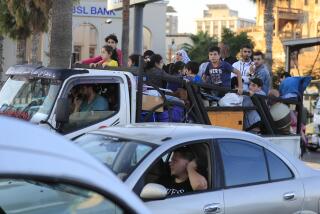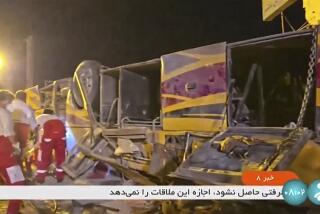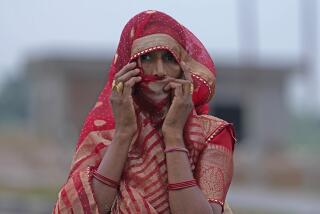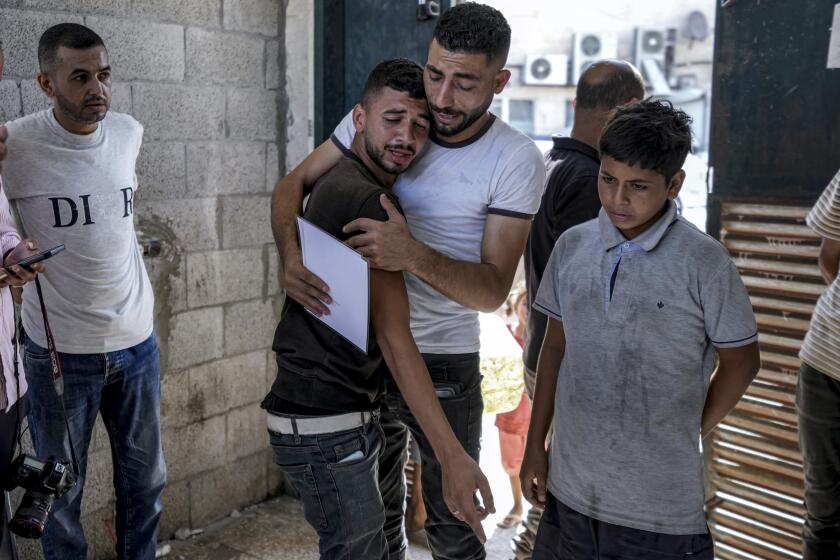Violent Rituals Gave Way to Violent Atrocity
KARBALA, Iraq — The worshipers had come to celebrate the most sacred holiday for Shiite Muslims at two of Iraq’s holiest sites, the twin mosques in this devout city and the revered shrine in Baghdad’s Kadhimiya neighborhood.
Many young men had beaten their backs with chains and struck their heads with swords in a bloody rite of worship and deference to their beloved Imam Hussein, a grandson of the prophet Muhammad who died in battle more than a millennium ago.
Then, without warning, the blood of ritual gave way to the blood of atrocity Tuesday: A series of blasts tore through the throngs in Karbala and the Baghdad mosque, killing scores. Instantly, the streets here that had been filled with orderly formations of the faithful filled with carnage, as people ran for their lives.
A detonation unleashed a huge fireball that whooshed down the street known as the Baghdad Gate in Karbala, the main entrance to the shrine area, which was overflowing with worshipers.
The blast’s smoky remnants met with slivers of shrapnel propelled from a nearly simultaneous suicide bomb on the far end of the street.
Victims dropped like stick figures as pandemonium reigned. Nobody knew where to turn as the blasts kept coming -- seven or eight in all -- and the sound of destruction echoed in the narrow streets.
In both cities, pilgrims had traveled far to pray at the hallowed destinations. Now the survivors stared in fury and horror at holy places profaned. Their symbolic mourning for Imam Hussein had been brutally transformed into real mourning for loved ones lost or maimed.
“This is a disaster for us,” said Hassan Amir, a 51-year-old engineer who surveyed the damage in Karbala where a suicide bomber struck outside an elementary school, killing several Iranian pilgrims, including a mother and her young daughter. “No one has the right to take life this wantonly.”
The size of the concentrated crowds -- as many as 1 million pilgrims descended on Karbala in this first celebration of the Ashura holiday in the post-Saddam Hussein era -- only served to set the masses up for slaughter.
The crowds were not as vast in the Baghdad shrine, but the bulk of victims had packed into a courtyard adorned with ornamental chandeliers, posters of Imam Hussein and black banners with religious slogans.
The trio of bombers deployed in an effective formation: one inside the courtyard at the entrance of the inner shrine, and one each at the southern and eastern gates of the courtyard.
The rapid sequence of explosions caught entire families in a triangular barrage of shrapnel.
“Most of the dead were children, women and elderly men,” said a witness, Ali Hussein, 30. “I can’t say exactly how many people were dead because many of them were blown up into pieces and got mixed up.”
In the aftermath, muscular Shiite militiamen with black bandannas and AK-47s filled the courtyard, enraged and sorrowful, ready to lash out at any perceived threat. They glared at outsiders, especially a nervous-looking contingent of Iraqi police arguing with a robed imam: He wanted the clumps of flesh and limbs removed for burial, while the police wanted to preserve the crime scene for forensics.
The imam prevailed.
The militiamen dumped human remains -- only a severed arm was recognizable -- into a wooden box. They covered it with a black banner and carried it away like a funeral procession.
“There is only one God, and he is Allah!” they chanted.
The scale of the massacres stunned even war-weary Iraqis, many of whom stepped forward to help evacuate the wounded and perform other tasks.
“These are human remains and should be treated decently,” Ahmed Abdel-Amir said as he meticulously collected pieces of human flesh and bone embedded into a concrete wall in Karbala, placing them one by one into a green plastic bag.
“I will clean these and give them a decent burial,” he said. “I hope that God recognizes my deed.”
White Mercedes ambulances with orange stripes raced through the streets, sirens screeching. Stunned pilgrims remained crouched in alleys and ditches. Policemen and militia members pointed pistols and Kalashnikovs, eyeing the crowds for anyone appearing suspicious.
Many survived, only to realize that their loved ones were missing.
They made their way to Husseiniya hospital, where two rooms held scores of dead, and wounded packed the wards.
Those inquiring about patients were instructed to stand outside the gate and await a periodic recitation of names.
At the Kadhimiya Teaching Hospital in Baghdad, a young nurse wasn’t looking for anyone. He wept as he carried the body of a 10-year-old boy whose parents had also perished.
Nobody knew the boy’s name.
More to Read
Sign up for Essential California
The most important California stories and recommendations in your inbox every morning.
You may occasionally receive promotional content from the Los Angeles Times.









